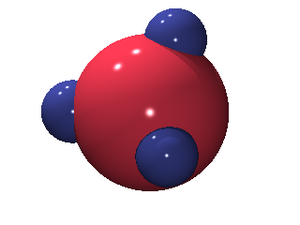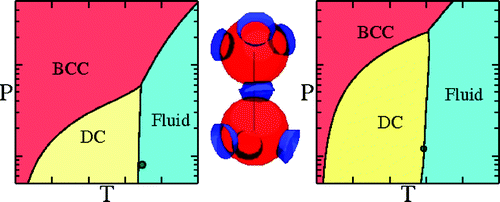Anisotropic particles with tetrahedral symmetry: Difference between revisions
Jump to navigation
Jump to search
m (Slight tidy.) |
Carl McBride (talk | contribs) m (Added photo box) |
||
| Line 1: | Line 1: | ||
[[Image:patchy_4.png|thumb|right| Artists impression of a tetrahedral patchy particle]] | |||
The '''phase diagram of tetrahedral''' [[patchy particles]] <ref>[http://dx.doi.org/10.1021/jp9081905 F. Romano, E. Sanz and F. Sciortino "Role of the Range in the Fluid−Crystal Coexistence for a Patchy Particle Model", Journal of Physical Chemistry B '''113''' pp. 15133–15136 (2009)]</ref> | The '''phase diagram of tetrahedral''' [[patchy particles]] <ref>[http://dx.doi.org/10.1021/jp9081905 F. Romano, E. Sanz and F. Sciortino "Role of the Range in the Fluid−Crystal Coexistence for a Patchy Particle Model", Journal of Physical Chemistry B '''113''' pp. 15133–15136 (2009)]</ref> | ||
exhibits the following solid phases: [[Building up a diamond lattice |diamond crystal]] (DC), | exhibits the following solid phases: [[Building up a diamond lattice |diamond crystal]] (DC), | ||
Revision as of 16:52, 22 February 2010

The phase diagram of tetrahedral patchy particles [1] exhibits the following solid phases: diamond crystal (DC), body centred cubic (BCC) and face centred cubic (FCC). The gas-liquid critical point becomes metastable with respect to the diamond crystal when the range of the interaction becomes short (roughly less than 15% of the diameter).
In contrast to isotropic models, the critical point becomes only weakly metastable with respect to the solid as the interaction range
narrows (from left to right in the figure).
